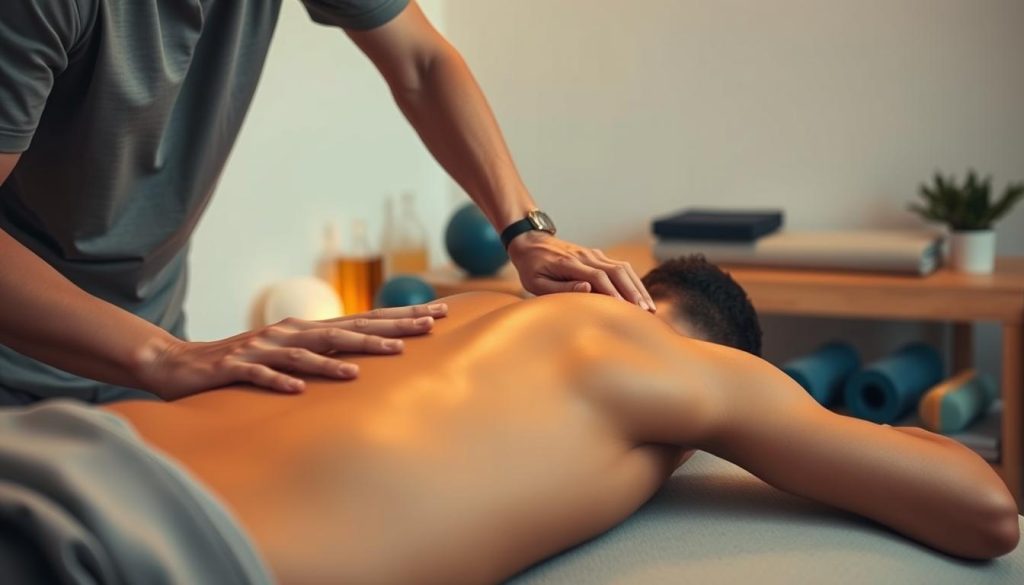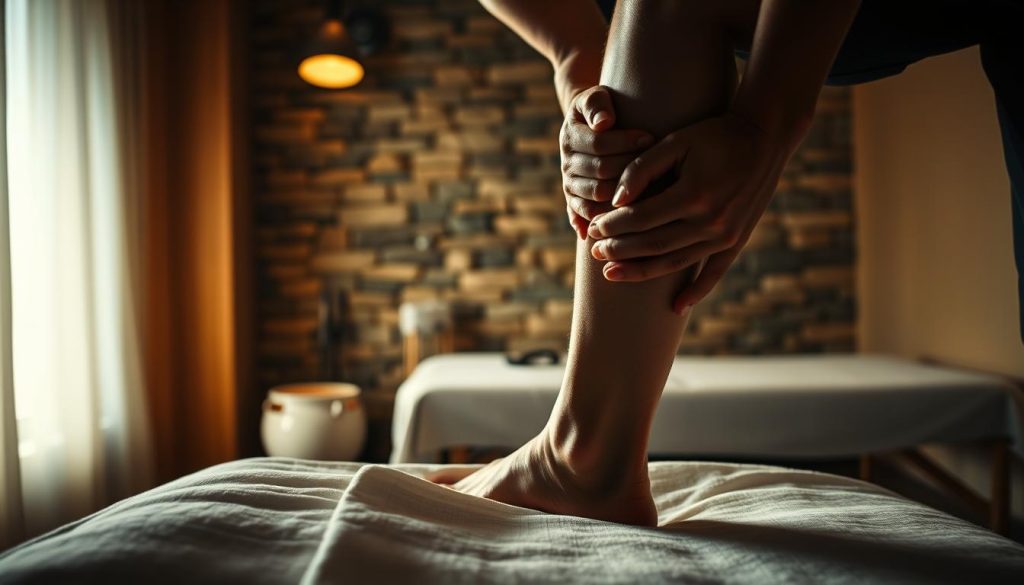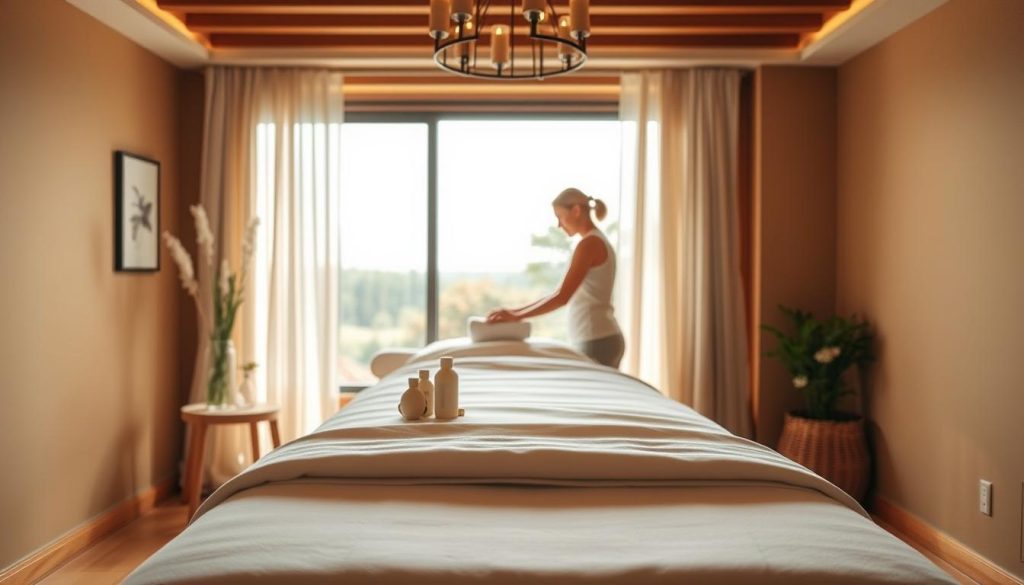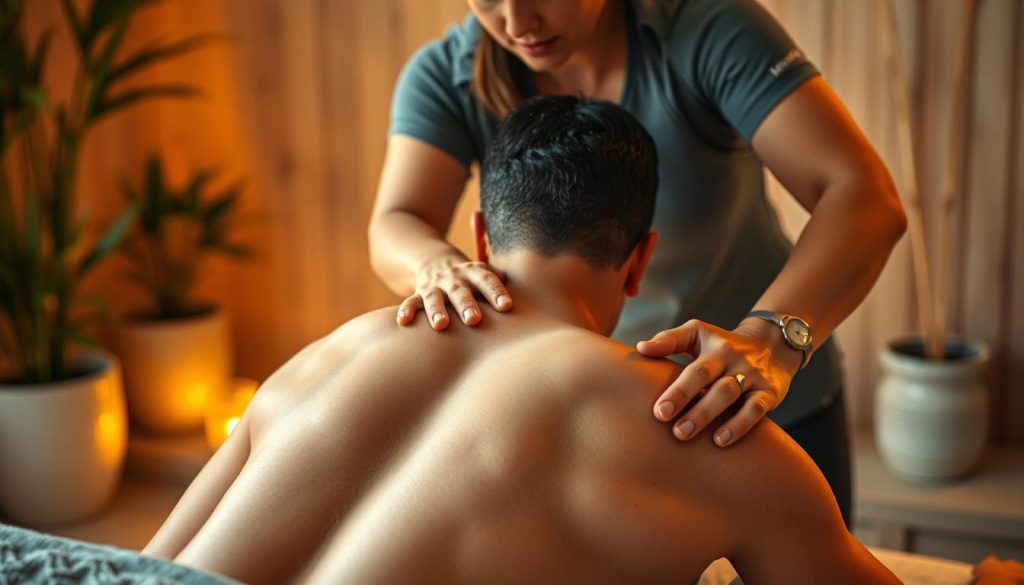Athletes are always looking for new ways to get better and recover faster. Sports massage at Riverside Sports Therapy is a key tool for this. It offers deep benefits that help athletes train and recover better.
Both pro athletes and weekend sports fans know that massage can make a big difference. It helps with muscle function, faster recovery, and better athletic performance. Sports massage meets athletes’ specific needs, keeping them in top shape and reducing injury risks.
Riverside Sports Therapy offers tailored massage plans for each athlete. They know that every athlete is different and needs a special approach to therapy.
Key Takeaways
- Sports massage provides complete performance improvement
- It helps with muscle recovery and prevents injuries
- Customized plans meet each athlete’s unique needs
- It boosts physical and mental health of athletes
- Massage is key for long-term athletic growth
Understanding Sports Massage Fundamentals
Sports massage is key for athletes to perform better and recover faster. It uses special massage techniques that help more than just relax. Athletes in many sports find it very helpful.

Coaches and athletes see sports massage as a way to stay in top shape. It mixes science about muscles with special treatments.
History and Evolution of Sports Massage
Sports massage started long ago, with ancient athletes using it to get ready for games. The Greeks and Romans used it to boost muscle strength and avoid injuries.
- Ancient Olympic athletes used basic massage techniques
- Early sports medicine experts developed detailed methods
- Modern sports massage began in the mid-20th century
Core Principles and Techniques
Sports massage focuses on helping muscles recover, tailored to each athlete. It aims to improve muscle function, reduce tension, and prevent injuries.
| Technique | Primary Purpose | Target Muscle Groups |
|---|---|---|
| Effleurage | Warming muscles | Large muscle groups |
| Petrissage | Deep tissue manipulation | Specific muscle layers |
| Friction | Breaking scar tissue | Localized problem areas |
Different Types of Sports Massage Methods
There are many massage types for athletes, each with its own benefits. They help with muscle recovery and improving performance in different ways.
- Pre-event massage: Gets muscles ready for big efforts
- Post-event massage: Helps with muscle soreness after
- Rehabilitation massage: Aids in healing from injuries
“Sports massage is not a luxury, but a critical tool for athletic excellence” – Professional Sports Physiotherapist
Knowing about sports massage basics helps athletes use advanced recovery techniques wisely.
Benefits of Sports Massage for Athletes
Sports massage is a powerful tool for athletes. It helps them perform better and stay in top shape. This massage is not just for relaxation. It offers specific benefits that help athletes train and compete better.
Athletes gain many benefits from sports massage therapy:
- Enhanced flexibility and range of motion
- Accelerated muscle recovery
- Reduced risk of injury prevention
- Improved muscle performance
Injury prevention is a key benefit. Sports massage helps athletes find and fix muscle issues early. This way, they avoid serious injuries.
“Sports massage is not just a luxury, but a necessity for serious athletes seeking optimal performance.” – Professional Sports Physiotherapist
Sports massage also boosts flexibility. Regular sessions can make muscles more elastic and reduce stiffness. This leads to better athletic performance in many sports.
| Massage Benefit | Performance Impact |
|---|---|
| Muscle Tension Release | Improved Power Output |
| Circulation Enhancement | Faster Recovery |
| Flexibility Improvement | Greater Range of Motion |
Adding sports massage to their training, athletes can see big improvements. They also protect their bodies from injuries.
Enhanced Athletic Performance Through Massage Therapy
Sports massage is a key tool for athletes wanting to improve their performance. It helps both professional athletes and weekend warriors. By using specific massage techniques, athletes can better their body mechanics and muscle function.
Massage therapy does more than just relax muscles. It gives athletes a strategic edge that can lead to success in competitions.
Improved Range of Motion
Flexibility is essential for athletes. Regular sports massage helps athletes by:
- Increasing joint mobility
- Reducing muscle tension
- Improving muscle elasticity
Better Muscle Coordination
Massage techniques can greatly improve how muscles work together. By focusing on certain muscle groups, therapists help athletes:
- Move more smoothly
- Use muscles more efficiently
- Be more aware of their body
Increased Power Output
Athletes looking to perform at their best can benefit from special massage techniques. Strategic muscle manipulation helps athletes:
- Recruit muscle fibers better
- Improve neural connections
- Boost overall muscle strength
“Massage is not just recovery; it’s a performance enhancement strategy.” – Professional Sports Physiotherapist
Accelerated Muscle Recovery and Healing

Athletes often go to great lengths, making muscle recovery key to their success. Sports massage is essential in easing muscle tension and speeding up healing after hard workouts or games.
The science behind muscle recovery is complex. Athletes face muscle damage and build-up of waste like lactic acid from intense activities. Sports massage helps by:
- Boosting blood flow to damaged muscles
- Helping remove waste faster
- Lowering inflammation and soreness
- Improving oxygen and nutrient delivery to muscles
“Effective muscle recovery isn’t just about rest—it’s about strategic interventions that support the body’s natural healing mechanisms.” – Professional Sports Physiotherapist
Massage techniques focus on muscle recovery with specific pressures and movements. Deep tissue manipulation breaks down scar tissue, while gentle strokes aid in lymphatic drainage. These actions greatly help in reducing muscle tension and speeding up recovery.
Professional athletes see sports massage as a vital tool for staying in top shape. By adding regular massages to their training, athletes cut down on recovery time and lower injury risks.
Preventing Sports-Related Injuries
Sports massage is key in stopping injuries for athletes. It helps athletes perform better and stay in their sport longer. This is because it manages injury risks well.
Athletes face many challenges in preventing injuries. Sports massage therapists can spot risks early. This stops serious problems before they start.
Identifying Risk Factors
Finding early signs of injuries needs a detailed approach. Important risk factors include:
- Muscle imbalances
- Repetitive strain patterns
- Biomechanical inefficiencies
- Previous injury history
Pre-Competition Preparation
Getting ready for events is key to avoiding injuries. Sports massage prepares athletes’ bodies for top performance.
| Preparation Technique | Benefit |
|---|---|
| Dynamic stretching | Increases muscle flexibility |
| Targeted muscle activation | Improves neuromuscular coordination |
| Soft tissue manipulation | Reduces muscle tension |
Long-term Injury Prevention Strategies
Using injury prevention strategies all the time can greatly lower injury risks. Regular sports massage keeps muscles healthy, finds problems early, and boosts athletic performance.
“Prevention is always better than cure in athletic performance” – Sports Medicine Experts
Athletes who focus on injury prevention through sports massage do better. They recover faster, stay healthy longer, and perform better overall.
Improving Blood Circulation and Oxygen Flow
Sports massage is key for better blood flow in athletes. It uses special techniques to boost circulation. This helps muscles get the oxygen and nutrients they need.
Getting better at sports starts with the cells. When blood flow goes up, muscles get more:
- Oxygen for energy production
- Nutrient-rich plasma
- Faster metabolic waste removal
“Optimal blood flow is the foundation of peak athletic performance” – Sports Medicine Research Institute
Athletes with better circulation see big benefits:
| Circulation Benefit | Athletic Impact |
|---|---|
| Enhanced Oxygen Delivery | Increased muscle endurance |
| Faster Waste Removal | Reduced muscle fatigue |
| Improved Nutrient Transport | Quicker muscle recovery |
Strategic massage techniques can transform an athlete’s circulatory system, creating a pathway for superior performance and recovery.
Mental Benefits and Stress Reduction
Sports massage offers deep mental benefits for athletes, beyond just easing physical pain. It’s a holistic approach that helps athletes deal with the emotional ups and downs of sports.
Athletic success isn’t just about being strong. It also depends on mental toughness. Massage can help athletes feel better mentally by easing muscle tension.
Anxiety Management
Professional athletes face a lot of pressure. Sports massage is a great way to handle this stress. It helps by:
- Lowering stress hormones
- Making athletes feel more relaxed
- Lessening mental stress before big games
Focus Enhancement
Being mentally sharp is key for athletes. Massage helps by:
- Lessening mental tiredness
- Boosting focus
- Keeping athletes calm
Sleep Quality Improvement
Good sleep is vital for athletes to recover. Sports massage helps by:
- Relaxing muscles
- Reducing physical tension
- Helping athletes sleep better
“Massage is not just about physical healing, but mental restoration.” – Sports Performance Expert
Athletes can use sports massage to improve their mental health. It helps them perform at their best, both physically and mentally.
Pre-Event Massage Techniques and Timing

Getting ready for a big event is key for athletes. A sports massage before competition helps them get ready physically and mentally. The right massage can make athletes feel more ready and confident.
Professional athletes know how important the right massage is before a game. They use special techniques to get their muscles ready, improve blood flow, and prepare their body for the best performance.
- Activate muscle groups 30-45 minutes before competition
- Use light, rapid massage strokes to stimulate circulation
- Target specific muscle areas related to the athlete’s sport
- Maintain moderate pressure to avoid muscle fatigue
When it comes to timing, it’s all about the right touch. Athletes should get a short, dynamic massage that gets them ready without making them too relaxed or tired. A good sports massage therapist will do a 10-15 minute session to warm up muscles and improve movement.
“Proper pre-event massage can be the difference between good and exceptional athletic performance” – Canadian Sports Medicine Association
Getting the most out of a pre-event massage means knowing what your body needs. Different sports need different massages, so it’s all about tailoring the prep to the athlete.
Athletes can get the most from their massage by talking openly with their therapist. Share your goals, any muscle issues, and what you hope to achieve in the game.
Post-Competition Recovery Strategies
Athletes go all out in competitions, making recovery key to staying at the top. Good recovery plans help muscles mend, lessen soreness, and get ready for more training.

Immediate Post-Event Care
Recovery starts right after an event. Sports massage is vital in this first step. It tackles muscle fatigue and aids in quick healing. Experts use special methods to:
- Reduce muscle tension
- Minimize inflammation
- Boost blood flow
- Stop muscle stiffness
“The first hour after intense physical activity is critical for effective muscle recovery” – Sports Medicine Expert
Long-Term Recovery Planning
Recovery goes beyond the first steps. Top athletes create detailed recovery plans. They mix different methods:
- Regular sports massage sessions
- Custom nutrition plans
- Active rest and specific rehab
- Watching muscle adaptation and stress
With structured recovery, athletes can keep their bodies in top shape. They lower injury chances and keep their performance steady in competitions.
Incorporating Sports Massage into Training Routines
Athletes know sports massage is key to better performance. Adding sports massage to their routine boosts flexibility and prevents injuries. It also helps athletes perform at their best.
“Consistent sports massage is not a luxury, but a strategic investment in an athlete’s body and performance,” says professional sports physiotherapist Dr. Sarah Thompson.
Creating a good sports massage plan takes thought and knowing what each athlete needs. Athletes should see massage as a way to stay ahead, not just to fix problems.
- Schedule massages during low-intensity training weeks
- Align massage sessions with training periodization
- Communicate specific muscle group concerns with therapists
- Use self-massage techniques between professional sessions
Sports massage does more than just relax muscles. It also boosts blood flow, lowers muscle tightness, and increases flexibility.
| Training Phase | Massage Frequency | Primary Objective |
|---|---|---|
| Pre-Competition | 1-2 sessions/week | Performance Optimization |
| Recovery Period | 2-3 sessions/week | Muscle Repair |
| Maintenance | 1 session/week | Injury Prevention |
Strategic massage integration can transform an athlete’s training approach, turning recovery into a performance-enhancing opportunity.
Choosing the Right Sports Massage Therapist
Finding the right sports massage therapist is key for athletes. It’s not just about feeling relaxed. It’s about improving performance and recovery.
Athletes need a therapist who knows their sport and training. Riverside Sports Therapy suggests looking closely at who you choose. This ensures you get the best care.
Essential Qualifications to Seek
- Certified sports massage certification from recognized institutions
- Specialized training in athletic performance and injury prevention
- Minimum of 3-5 years experience working with professional athletes
- Advanced understanding of muscle mechanics and sports-specific rehabilitation
Critical Questions for Your Potencial Therapist
- What sports-specific training do you have?
- Can you provide references from professional athletes?
- What techniques do you specialize in for performance enhancement?
- How do you customize treatments for different athletic needs?
| Qualification Level | Experience Requirements | Recommended Certification |
|---|---|---|
| Entry Level | 1-2 years | Basic Sports Massage Certification |
| Intermediate | 3-5 years | Advanced Sports Therapy Diploma |
| Expert Level | 5+ years | Professional Sports Medicine Certification |
“The right sports massage therapist is a game-changer for athletic performance and recovery.” – Sports Medicine Expert
Riverside Sports Therapy is known for its skilled team. They help athletes reach their best through expert sports massage.
Common Sports Massage Techniques Explained
Sports massage uses special techniques to help athletes feel less muscle tension and pain. Professional therapists mix different methods to boost athletic performance and aid in recovery.
The main techniques in sports massage are:
- Effleurage: A gentle stroking that warms muscles and boosts blood flow
- Petrissage: Kneading that breaks down muscle knots and relaxes deeper tissues
- Friction: Deep pressure to tackle muscle adhesions and trigger points
- Tapotement: Rhythmic tapping that wakes up muscles and boosts nerve activity
Each method has its own role in easing pain and helping muscles recover. Effleurage gets muscles ready for deeper work. Petrissage targets deeper layers to release tension. Friction helps break down scar tissue and boosts muscle flexibility.
“Effective sports massage is an art of understanding each athlete’s unique muscular needs” – Sports Therapy Professionals Association
Athletes gain from these techniques by seeing better muscle flexibility, less injury risk, and quicker recovery. Therapists tailor these methods to meet each athlete’s needs, ensuring top performance and less muscle tension.
Sports Massage for Different Athletic Disciplines
Athletes in various sports need special massage techniques. These techniques help improve their performance and meet their physical needs. Sports massage is tailored to fit each sport’s unique demands.
Good sports massage can greatly boost an athlete’s performance and recovery. It also improves their physical condition. Knowing what each sport needs helps massage therapists use the right techniques.
Endurance Sports Strategies
Endurance athletes, like runners, cyclists, and swimmers, benefit from sports massage. It helps:
- Reduce muscle fatigue
- Boost oxygen flow
- Prevent injuries from repetitive strain
- Improve muscle flexibility
Power Sports Techniques
Power athletes, such as weightlifters, sprinters, and jumpers, need special massage. It focuses on:
- Releasing muscle tension
- Preparing for explosive power
- Speeding up muscle recovery
- Lowering the risk of muscle tears
Team Sports Considerations
Team sport athletes, like football, basketball, and soccer players, gain from sports massage. It helps with:
- Quick recovery between games
- Handling stress from moving in many directions
- Preventing injuries from overuse
- Keeping them in top shape
“Sports massage is a key part of an athlete’s training and recovery plan.”
| Athletic Discipline | Primary Massage Focus | Key Benefits |
|---|---|---|
| Endurance Sports | Circulation and Flexibility | Less Fatigue, Better Performance |
| Power Sports | Muscle Tension Release | Better Power, Faster Recovery |
| Team Sports | Comprehensive Muscle Care | Prevent Injuries, Quick Recovery |
By tailoring sports massage to each sport, therapists help athletes perform better. They also improve their overall health.
When to Schedule Your Sports Massage Sessions
Timing is key when adding sports massage to your training. It’s important for getting ready before events and recovering after. This helps you perform better and stay injury-free.
When planning massage sessions, athletes need to think about a few things:
- How hard you’ve been training and when you have competitions
- How fast your muscles recover
- The specific needs of your sport
- How your body reacts to massage
“Massage is not a luxury, but a critical component of athletic performance and recovery.” – Professional Sports Physiotherapist
To get the best results, athletes should follow these timing tips:
- Heavy Training Periods: Get deep tissue massages 2-3 days after hard workouts
- Tapering Phases: Have light massages 48-72 hours before big competitions
- Recovery Periods: Do regular maintenance massages every 1-2 weeks
Every athlete is different. Working with a sports massage therapist can help create a plan that fits you. This plan supports you before events and helps you recover after.
Services at Riverside Sports Therapy
Riverside Sports Therapy is a leader in helping athletes perform better. We offer sports massage services for athletes at all levels. Our team knows what athletes need and uses special massage techniques to help them.
Professional athletes and weekend warriors alike trust our complete sports massage therapy.
- Customized massage treatments for individual athlete needs
- Advanced sports massage techniques
- Performance optimization strategies
- Injury prevention and recovery support
“Our mission is to help athletes reach their peak performance through expert sports massage techniques.”
Our sports massage services include:
- Pre-event preparation massages
- Post-competition recovery treatments
- Rehabilitation massage therapy
- Performance enhancement sessions
Want to improve your athletic performance? Call Riverside Sports Therapy today at (403) 283-7551 for a sports massage consultation. Our skilled therapists are ready to help you reach your athletic goals with targeted massage techniques.
Book now and see the amazing benefits of sports massage for athletes!
Conclusion
Sports massage is key for athletes to improve their game. It does more than just relax; it boosts performance and prevents injuries. Top athletes in Canada see it as vital for staying in top shape.
Massage helps athletes recover faster and move better. It reduces muscle tightness and boosts blood flow. These changes help athletes perform better and more efficiently.
Seeing sports massage as a must, not a luxury, is smart. Riverside Sports Therapy offers services to help athletes at all levels. It’s great for getting ready for big events or recovering from hard workouts.
Sports massage is more than just a treatment; it’s a way to prevent injuries and improve performance. It helps with muscle stress, quickens recovery, and gets athletes mentally ready. It’s a game-changer for athletes looking to reach new heights.
For more details, visit: https://www.riversidesportstherapy.com/2025/01/21/why-athletes-choose-sports-therapy-for-injury-relief/
For more details, visit: https://www.riversidesportstherapy.com/calgary-contact/
